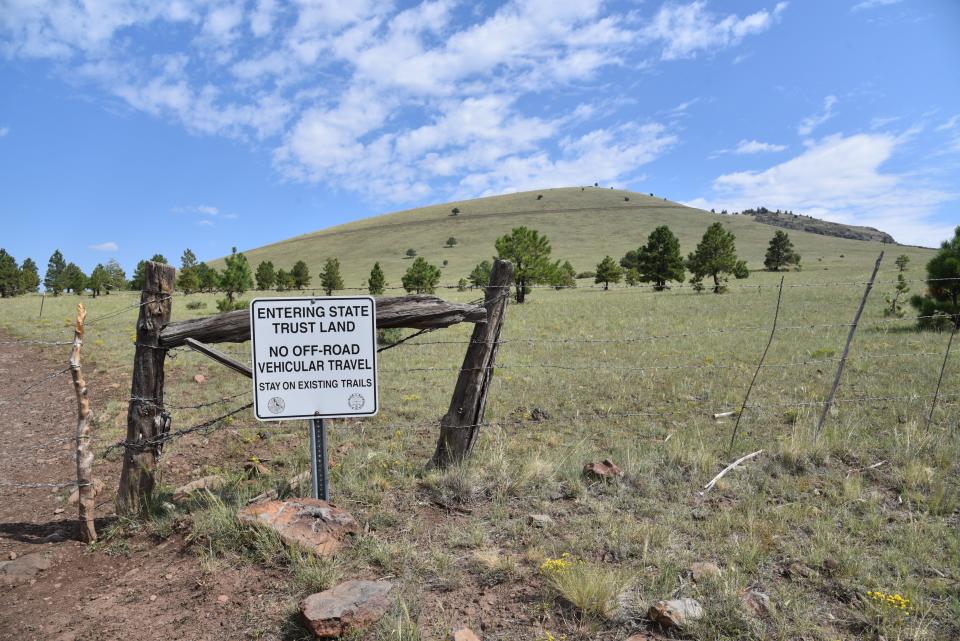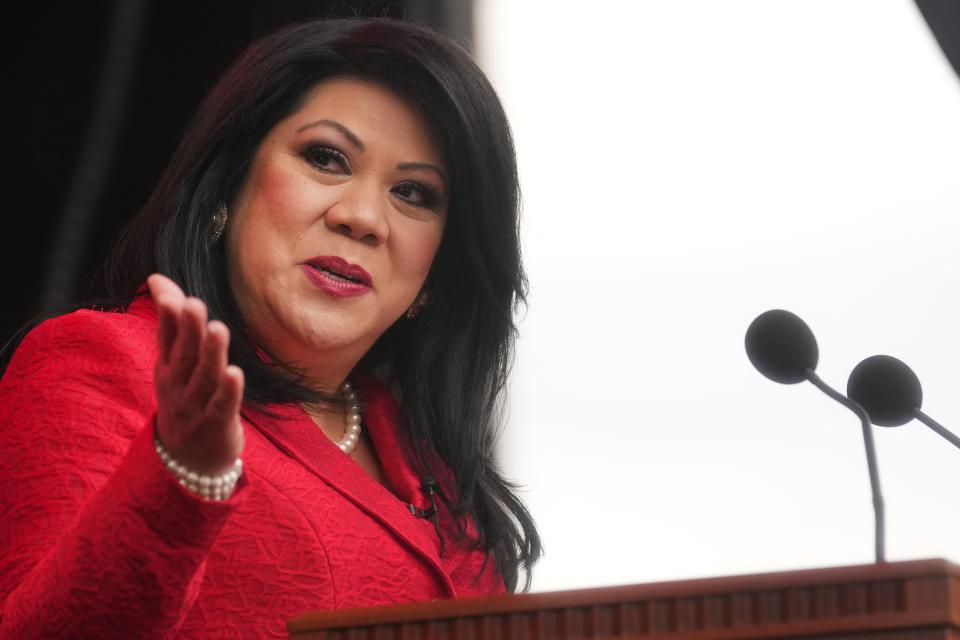How does Arizona land trust help pay for schools? And what could change in 2024?
- Oops!Something went wrong.Please try again later.
Corrections & Clarifications: An earlier version of this article gave an incorrect date for when the State Land Department began investing in the stock market a portion of the money it earned from land sales.
More than a century ago, the federal government made the new state of Arizona set aside nearly 11 million acres of land in a trust, mainly for the benefit of schools.
More than 9 million of that total acreage remains in play today, and the money paid to the state annually from an investment fund based on sales and leases of that land have contributed billions of dollars to schools.
Republican lawmakers in November 2023 proposed a solution to boost teacher pay that makes use of the fund, which reached a record monthly high of $8.2 billion. If the GOP-led Legislature approves the new plan, it would go before voters in November 2024 without requiring Democratic Gov. Katie Hobbs' signature.
But voters — and Congress — still would have to approve the new plan.
Whether that plan goes into effect or not, the state land trust will continue to pump substantial funds to public schools. Here's how the time-tested trust plan works:
Congress set up land trust
Arizona's trust began in 1910, two years before statehood, with the federal Arizona-New Mexico Enabling Act. Congress set aside 10.9 million acres in Arizona, the 48th state.
The state Legislature and people of Arizona decide how that land would be used to fund schools and other beneficiaries, subject to congressional approval.
The Arizona State Land Department manages, sells and leases these acres. Each month, the department sends the money it makes to the state Treasurer's Office, which invests it in the Permanent Land Endowment Trust Fund.
Land sales have slowed since the 1970s, according to State Land Department data.
The state sold or otherwise dispersed of 1.3 million acres from 1912 to 1978. About 600,000 acres have been dispersed since 1978, reducing the land trust to 9.2 million acres from roughly 9.6 million acres.

Massive growth in Permanent Land Endowment Trust Fund
The State Land Department's goal is to maximize its returns on land sales. The Permanent Land Endowment Trust Fund's goal is to maximize the state's investment from those lands.
In 1999, the state began investing a portion of the money in the stock market. This change allowed the permanent fund to grow exponentially. It stood at less than $800 million in 1996. In December 2023, the fund reached its highest point ever at $8.2 billion, as state Treasurer Kimberly Yee announced Dec. 15.
That would put more than $424 million for public education in the state's budget for fiscal year 2024, according to the Yee's office.
How much money does this generate, and who gets it?
K-12 schools receive most of the returns from the permanent fund, roughly about $350 million a year in recent years. But other entities receive fund money, too, including universities, the Arizona State Hospital and School for the Deaf and the Blind, the juvenile and adult corrections departments, and the state Legislature.
The formula for how much schools get from investments on land sales has varied over the years. In 2016, voters approved Proposition 123, a plan to satisfy a lawsuit over the state's failure to obey a 2000 voter-approved ballot measure requiring that expenditures for schools keep up with inflation. Proposition 123 raised the amount taken from the permanent fund and distributed to beneficiaries, including schools, to 6.9% from 2.5% per year.
The proposition expires in 2025, so proponents of extending it need voters to pass another ballot measure in 2024.
Have investments paid for Proposition 123? Will that continue?
Yes, according to state Treasurer Yee, but only because of a "rebalance" plan to avoid strict adherence to a traditional, and constitutionally mandated, 60/40 mix of stocks vs. bonds and cash reserves in the fund.
The state sells a little of either stocks or bonds when the mix departs the normal ratio by plus or minus 2.5%, she said.
The payout to schools and the other beneficiaries is based on the average market value of the fund over the past five years.
"Under my leadership, over $1.8 billion has been distributed to PLETF beneficiaries since December 31, 2018," Yee said in a statement to The Arizona Republic. "The endowment beneficiaries will receive $110.7 million more in this fiscal year than when I first took office, with K-12 education receiving the majority of the increase at $424 million. This is excellent news for our K-12 schools across Arizona.”

Experts can't predict whether the good run of investments would continue for another 10 years.
"Past performance is no guarantee of future results," Yee said. "Most Wall Street forecasters forward returns forecast for the next 10 years indicate a 60/40 fund will return on average between 5% and 6% a year."
That means extending Proposition 123's 6.9% distribution could put some of the permanent fund's principal at risk — making it less permanent.
If Proposition 123 doesn't get extended, the distribution amount will fall back to 2.5%, a conservative amount designed originally to preserve the permanent fund's principal while still providing millions to public schools.
The law requires the $300 million shortfall that would occur for the state's fiscal year 2026 without an extension to be backfilled by the state General Fund, with some exceptions. Lawmakers could reduce the funding.
Lawmakers propose to use land trust to boost teacher pay
Written legislation for the GOP plan announced in November hasn't yet been submitted, but it could extend the same 6.9% payout plan from Proposition 123.
The "new" money collected by extending Proposition 123 would fund a statewide increase in teacher pay. Senate President Warren Petersen, R-Gilbert, said teachers would make an average of $4,000 more per year under the plan, increasing their average pay to more than $60,000 a year.
The Legislature would use the state's general fund to keep providing schools with the roughly $350 million per year they've been getting from Proposition 123.
Lawmakers haven't yet said whether they'd also keep contributing another $50 million to $75 million per year to schools, another funding stream required under Proposition 123 that expires in 2025.
The governor, for her part, said in November that the expiration of Proposition 123 in 2025 will spur "a lot of lively conversation."
How well has Prop 123 worked for public schools?
On one hand, increasing payouts to schools using the land trust under Proposition 123 worked well, said Chuck Essigs, director of governmental relations for the Arizona Association of School Business Officials.
Critics feared that "Prop. 123 was going to decimate the land trust," he said. Instead, the trust performed better than ever.
Yet Arizona remains behind the curve in several key areas of school funding. Besides relatively low teacher pay, per-pupil spending Arizona was 48th in the nation when Proposition 123 began and is still at 48th today. Worse, Essigs pointed out, is that average spending on Arizona students has fallen further behind in recent years compared with the national average.
A 2022 Auditor General report shows that average per-student spending in Arizona was $11,170 in 2020, which is about two-thirds of the national per-student rate of $15,696.
Education officials remain concerned about potential shortfalls in school funding in the next few years, Essigs said.
He cited problem areas such as state revenues keeping up with needs after passage of lower state income tax rate, school-funding triggers that could allow lawmakers to set rates below the annual cost of inflation, and the impact to the General Fund of public charter schools and voucher-subsidized private schools that aren't funded with local property taxes.
Reach the reporter at rstern@arizonarepublic.com or 480-276-3237. Follow him on X @raystern.
This article originally appeared on Arizona Republic: Arizona's land trust fund helps pay for schools. Will that change?

